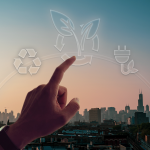What We Can Learn From the Greenest Countries in the World
The EPI (Environmental Performance Index) is a Yale-conducted data-driven ranking of 180 different countries based on environmental health and ecosystem vitality. It’s essentially a numbered list of the most-to-least green countries. The most recent EPI list was released in 2020, and this may or may not come as a shock – the U.S. was ranked number 24. Now 24 out of 180 isn’t bad, but it does tell us that we have a lot to work on. With Earth Day approaching, there isn’t a better time for us to take some notes from the top 3 most sustainable countries and learn what we can do to improve our environmental health here in the U.S.
- Denmark: Denmark has always been a heavily agriculture-based nation and prides itself on it’s fierce respect for the land and natural resources. Denmark’s capital city, Copenhagen, is one of the most sustainably advanced in the world. From solar-powered boats, to electric buses, and even Copenhill – a green-energy power station that turns waste into energy and supplies it to tens of thousands of homes and businesses – Copenhagen takes the lead in green innovation. The city waterways are so clean you can even swim in them! The Danish government puts sustainability at the forefront of all it’s initiatives, which places it rightfully at the top of the EPI list.
2. Luxembourg: One of the smallest countries in Europe, Luxembourg is mainly covered in agricultural and forest land, which may be a big factor in why the nation scored 100% in two categories on the EPI – Biodiversity and Water & Sanitation. Additionally, Luxembourg was found to produce nearly zero pollutant emissions, resulting in just fractions of a point shy of being the number one greenest country. Back in September, Luxembourg became the first European country to launch a Sustainability Bond Framework. This framework will enable the issuance of sustainability bonds that will encourage greener, more responsible financing and development.
3. Switzerland: Like the top two green countries, Switzerland’s government plays a big role in the nation’s focus on environmental preservation. The Federal Council pursues sustainable policies that include generating renewable energy, recycling anything and everything, and responsible resource usage. Last year, they enacted the Swiss Soil Strategy, which intends to reach zero net soil loss by 2050. The strategy will attempt to end soil degradation, implement a “replace what you use” rule, and prevent urban sprawl from damaging fertile soil.
These three leading countries can tell us a lot about sustainable practices and environmental preservation, but what really stands out is that they all have one major thing in common – they put sustainability at the forefront when it comes to creating new policies, urban development, and technological advancement. By adopting this sustainability-driven mindset, we here in the U.S. have the potential to drastically increase our contribution toward a greener planet. It’s essential for all of us to learn from each other, and do our best to work together as a nation and furthermore as a planet to preserve what we have.






